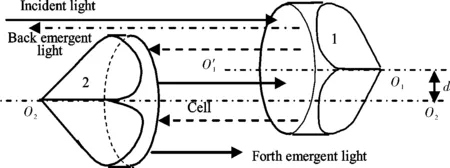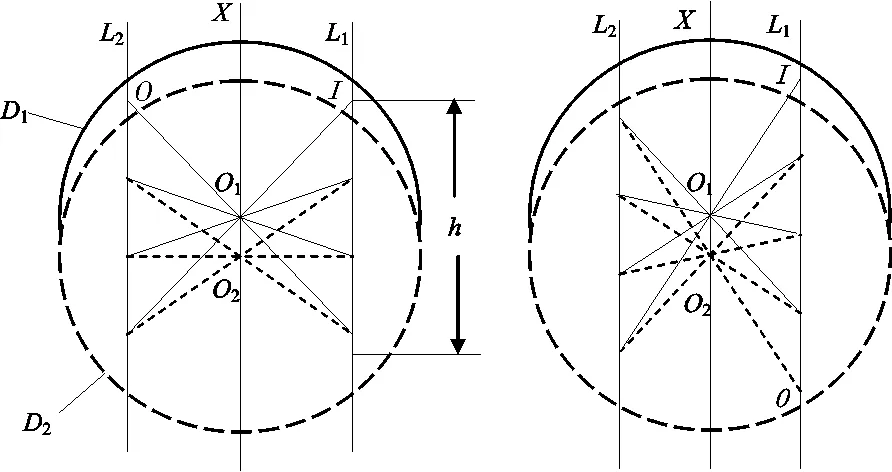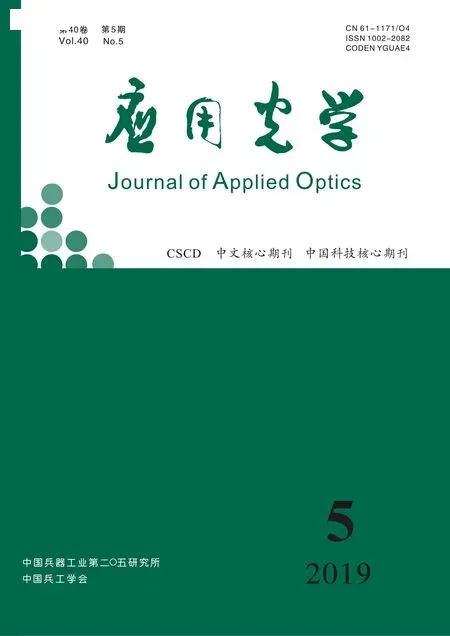基于角反射镜的气体传感器
肖韶荣,华 栋
(1.江苏大气海洋光电探测重点实验室,江苏 南京 210044;2.江苏省大气环境与装备技术协同创新中心, 江苏 南京 210044;3.南京信息工程大学 物理与光电工程学院,江苏 南京 210044;4.南京信息工程大学 电子与信息工程学院,江苏 南京 210044)
Introduction
Absorption cell is an important component in a spectrum absorption gas sensor, its configuration affects sensitivity and stabilization of application system. Several smart configuration forms were introduced[1]. Their performances are stabilized, configurations are simple, and their factures are easy, but interaction length is small between probing light and gas to be measured, therefore, sensitivity is small. Generally, an optics cell is utilized in which probing light travels back and forth, in order to extend the interaction length. There are typical cells, such as White cell[2-3], Herriott[4]cell, and correlation changed cells[5]. White cell may achieve a few meters to thousands meters, but its configuration is complicated, and its adjustability is poor for online measurement. Herriott cell is simpler than White cell, due to a confocal configuration adopted, only fourfold length effective interaction length may come true, and in case the configuration is confirmed, its effective interaction length cannot change. White cell is influenced by the placement surroundings. A multi-path absorption cell was put forward by Chernin[5], the cell has long length configuration, but its combination precision is too high to suit real time measurement system.
In order to satisfy the changing of sensitivity in inspecting system[6], manifold high stability absorption cells were designed[7-8], their long-term stability was improved based on rectangular prisms. In the paper, a cell is introduced based on corner cube prisms[9]. The cell is provided with better characteristics.
1 Configuration and transmission equation of cell-based corner cube prisms
1.1 Configuration of cell-based coner cube prisms
It is known that corner cube prism is formed with three right-angle planes one to one,which is schematically depicted in Fig.1 . The underside is upright to the axis. Emergent light beam travels back in parallel with incident light beam through the underside.

Fig.1 Constructive characteristics of corner cube prism
Optical path of the cell constructed with two corner cube prisms is shown in Fig.2. Two undersides are parallel, and their axes are parallel with no superposition. Probing light is transforming into small parallel beam at side inlet of the cell, and is normally incident to underside of prism 1. Emergent light passing through prism 1 is normally incident to underside of prism 2. Emergent light from prism 2 is normally incident to underside of prism 1 too. Thus, to-and-fro running, the probing light is coupled into the cell. The probing light from prism 1 travels in reverse to original incidence light with a distance, such as shown as broken line in Fig.2, this light is called as back emergent light. The probing light may run from prism 2, the light is called forward emergent light. The emergent light intensity is relation to the concentration of gas in the cell,the effective length of the cell and the times of probing light traveling in the cell, etc.

Fig.2 Construction of cell composed of two corner cube prisms
1.2 Analysis of light traveling in cell
The tracks of light in cell may be figured with spots on the two underside of the prisms. According to the characteristics of corner cube prism, after perpendicularly coming into the cell, the tracks of probing light are parallel group beams, they are distributed with regard to the two prisms, as shown in Fig.3. Let linexbeing coplanar with axes of the prisms, the line is vertical to the axes, taking the pointO2as origin. Because of every incidence and emergent light spot on underside,D1andD2is symmetrical with regard to centreO1andO2, separately. According to geometry and ray illustrating, the spots on undersides of the two prisms are uniformly distributed on sides of lineX, the distances of spots to linexare uniform. Spots of light enteringD1are arranged on lineL1, and spots coming out ofD2are arranged on lineL2. On the other hand, spots of light entering intoD2are arranged on lineL2, and spots departing fromD2are arranged on lineL1. In terms of the median of a triangle, the distance between the two contiguous spots onL1andL2is 2d, wheredis the distance between axes of the two prisms. From Fig.3, it is known that probing light travels back and forward in the cell, as well as the cell-based rectangular prism[7].

Fig.3 Distribution of spots by light beams on D1 or D2
1.3 Light transmission equation in cell
Let the centre of incidence light spot place at pointIon underside of prismD1, and pointIis on lineL1. The distance between pointIand intersect point is expressed ash, the intersect point is formed by lineL1passing through the edge of underside of prism 1. Times of probing light passing through the underside of prism 1 is
(1)
If emergent light is back emergent light, the times of light travels in the cell is even, and if it is forward emergent light, the times is odd. Effective length of the cell is marked inl, the effective optical length of probing light for back emergent light is
L=2Ml
(2)
Total time of back emergent light passing through undersidesD1andD2is 4M-2. Interfacial reflection and loss of material made from prism for probing light are considered, the intensity of back emergent light is
Iout=IinτM-2·e-k′M(l1+l2)·e-2kMl
(3)
In Eq. (3),Iinis incidence light intensity,τis transmission ratio of underside of the two prisms, it is about 96 %,l1andl2are the length of light travels through prism 1 and prism 2, separately,kis extinction coefficient of gas in the cell,k′ is extinction coefficient of material from which prism is made. The absorption coefficient of quartz is vary small near infrared. Generally,the diameter of corner cube prism is less than 50mm. Bothl1andl2are less than intervallbetween the prisms. IfMis larger, the extinction coefficientk′ may affect intensity of emergent light in evidence. Thus absorption of material may be ignored in the visible and near infrared range at smallM.
For forward emergent light, the effective optical length of probing light may be expressed in the form:
L=(2M+1)l
(4)
The total time of forward emergent light passing through undersidesD1andD2is 4M; the intensity of forward emergent light can be written as
Iout≈Iinτ4M·e-k(2M+1)l
(5)
From Eq. (1)~Eg. (3), it is known that the effective length of probing light can be changed with changing of distance between centre axes of both prisms, sequentially the sensitivity of cell can be changed. Whendis smaller, effective lengthLis larger, andLis changed withdobviously. It is shown that ifdis smaller, the adjusting efficiency of the cell light length is higher. It is indicated that the cell based on corner cube prism is propitious to miniaturization of gas sensor configuration.
In Eq. (3) and (5), the back reflection of undersides of prisms is not considered. If there is lean between undersides of prisms, back reflected light is not repeated, and therefore the back reflection of interface may be ignored. Here incidence light beam is taken as benchmark being referenced byd,dis distance between parallel lines passing through both prisms separately.
2 Analysis on sensitivity of cell
For the sensor, input physical magnitude is intensity of gas measured, and output magnitude is light intensity or absorbance[10]. The sensitivity of cell is defined as the output magnitude produced by unit input magnitude.
2.1 Sensitivity for single wavelength measurement
Emergent light intensity is given by Eq. (5), if there is no gas to be measured, emergent light intensity can be written as
Iout(λ)≈Iin(λ)τ4M
(6)
whereIout(λ) is equivalent to incidence light intensity of the cell, Eq.(5) can be rewritten in the form:
(7)
wherek(λ) is extinction coefficient of the gas measured at wavelengthλ. Therefore absorbency for single wavelength measurement is expressed as
(8)
In Eq. (8),Nis times of probing light travels back and forward in the cell, andN=2M+1. The sensitivity of cell is defined as change in absorbency or light intensity produced by unit gas concentration. Thus sensitivity of cell for single wavelength measurement is put forward as
(9)
From Eq. (9), it is known that sensitivity of cell is proportional toN, and sensor sensitivity may be changed with adjusting distanced.
2.2 Sensitivity for differential optical absorption spectroscopy
There is weak absorption of else gases, or the absorption coefficient changes slowly with wavelength in arrange of absorption of the gas measured. The single wavelength light is selected as probing light; measured gas absorption coefficient is larger than the ones of else gases at the wavelength. Another wavelength light is utilized as referenced light, at which absorption is weaker for measured gas and else gases. The wavelength of probing light is marked asλ, and that of referenced light is marked asλr. Molar absorption coefficients of gas measured for probing light and referenced light are marked asα(λ) andα(λr), separately.β(λ) andβ(λr) are taken separately to describe loss of light intensity produced by probing light and referenced light running in the cell except absorption. Probing light intensity exported from the cell is
(10)
Referenced light intensity exported from the cell is given by
(11)
From Eq. (10) and (11), we can get

[β(λ)-β(λr)]
(12)
Let probing light and referenced light travel along same optical path, and wavelength of probing be close to that of referenced light. Therefore there is relation ofβ(λ)≈β(λr). Measured gas concentration may be expressed by
(13)
Difference of absorbency is introduced
(14)
or is rewritten in the form:
δA=Nlc[α(λ)-α(λr)]
(15)
here,AandArare separately absorbency of probing light and referenced light. For differential optical absorption spectroscopy (DOSA)[11], sensitivity of the cell is
(16)
Generally, ratio of intensity at two near wavelengths from same source may be regard as constant. From Eq. (13), influence from changing in the light source may be ignored. Eq. (16) indicates that sensitivity of DOAS is proportional toN. On the other hand, in order to improve inspecting sensitivity, probing and referenced wavelength light should be chosen, in which difference betweenα(λ) andα(λr) is larger.
3 Experiment results and analysis
3.1 Observation of cell stability
The same two corner cube prisms were used to form an absorption cell. The diameter of the prism is 38 mm. The position of the incident spot is adjusted at the lower side of the prism 1 so that the distancehis 30 mm. From Eq. (1), it is known thatMvaries with distanced, and the variation curve is shown in Fig. 4. If the distancedis less than 2 mm,Mmay change from one number to another asdchanges in 0.1 mm. Whendis small, the probing beam is destroyed, especially when the beam cross section is larger, it is easier to destroy. Therefore, the cross section of the probe beam should be limited. When the distancedis large,Mkeeps stable, distancedvaries greatly,dvaries within 0.2mm and M keeps at 9. When m is less than 8,dcan be changed in a larger displacement. Generally, the absorption cell is stable whendchanges in a small displacement range due to environmental factors at a certain value.

Fig.4 M changing with distance d
3.2 Cell used into inspecting of methane
There are absorption peaks of methane near wavelength 1.33 μm and 1.65 μm. Halogen tungsten lamp was used as light source. Light of wavelength 1.33 μm from the source is obtained by spectrometer. It is considered that there are gases of CO, CO2, NH3and H2S, etc. in the air, there being absorption near wavelength 1.65 μm with them, and they may disturb measurement for CH4. Therefore referenced wavelength was taken as 1.27 μm, and InGaAs-PIN detector was used. Effective length of cell was taken as 50 cm, diameter in section of cell is 6 cm. Two planes made of fused quartz were used window at two ends of cell, and they are placed in parallel. Setup of measuring concentration of CH4is shown in Fig.5, being measured sample is natural gas.

Fig.5 Diagram of measuring concentration of CH4
3.3 Data processing and analysis on results
From Eq. (13), concentration of measured methane may be expressed as
(17)
Here,U0(λ) is output voltage from data collector being relational to equivalent incidence probing light, andUout(λ) is belong to emergent probing light.U0(λr) is relational to equivalent incidence referenced light, andUout(λr) comes from emergent referenced light.

(18)
By Eq. (17) and (18), we can get
(19)
It is shown in Eq. (19) that concentration of gas may be acquired with probing and referenced light intensity output at differentNin the cell.
In the application,α(1.33 μm)-α(1.27 μm)≈1.6m-1,l=0.5m,N=3,N′=5,ΔN=2. Output voltages from data collector are separately
Uout(1.33 μm)=1.396 V
Uout(1.27 μm)=1.233 V
From Eq. (19), concentration of methane for the sample is about 2470ppm, the result approaches that of gas chromatography method. Precision of A/D in the collector is 15 bits, drift instability of output voltage is less than 1 mV, and precision of output voltage is about 0.02%. IfNis 3, it is tested that detection threshold of the cell for methane is about 120 ppm. Times of probing light traveling in the cell was increased to 7, detection threshold of the cell approached 50 ppm. The threshold is about quarter of the data by Ref.[12].
Sensitivity of the cell dependence on times of probing light traveling for single wavelength is shown in Eq.(16). Action produced by portion reflection of the undersides on sensitivity of the cell was observed. When times of probing light traveling back and forward is smaller, sensitivity of the cell is proportional toN. If the times is larger, relation of sensitivity of the cell dependence on the times is not proportional. But sensitivity of DOAS is proportional toN, whether N is large or small.
4 Conclusion
Light transfers equations of the cell based on corner cube prism may be used as measurement equations for gas concentration. Back emergent light and probing light are placed two sides of plane formed by axes of the two prism separately, they are apart a large distance. Both incidence and emergent light may be placed same terminal, and configuration of measurement system can be compact. Sensitivity of the cell is proportional to times of probing light traveling back and forward in single wavelength under certain condition, but sensitivity of DOAS is always proportional toN. The detection threshold of the absorption cell is inversely proportional to the number of light returns in the cell.

